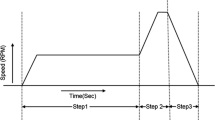Abstract
In this paper, the effect of perforations on both pull-in voltage and S-parameters have been studied experimentally and compared with the simulation results of perforated and non-perforated switch designs for validation. The perforated switch is fabricated using 4-mask layer process and low pull-in voltage of 1.85 V is achieved by introducing novel iterative methodology which reduce spring constant of meanders. The switch shows good insertion loss of − 0.16 dB and isolation of − 54.8 dB at 40 GHz. Due to perforations, the deviation of pull-in voltage is observed from 1.6 V to 1.85 V and also decrement in capacitive area results in frequency shift of 1000 MHz which shows huge effect in operating frequency of RF MEMS switch. The proposed switch can be efficiently used for 5G GSMA applications operating at 40 GHz frequency.










Similar content being viewed by others
References
Casha O, Micallef J, Grech I, Gatt E (2007) Utilisation of microsystems technology in radio frequency and microwave applications. J Malta Cham Sci 12:4–16
Elshurafa AM, El-Masry EI (2006) Effects of etching holes on capacitance and tuning range in MEMS parallel plate variable capacitors. In: The sixth international workshop on system-on-chip for real-time applications, pp 221–224
Fang DM, Li XH, Yuan Q, Zhang HX (2010) Effect of etch holes on the capacitance and pull-in voltage in MEMS tunable capacitors. Int J Electron 97(12):1439–1448
Girija Sravani K, Koushik Guha K, Rao S, Elsinawi A (2019) Design of a novel structure capacitive RF MEMS switch to improve performance parameters. IET Circuit Dev Syst 13(7):1093–1101
Girija Sravani K, Koushik Guha, and K Srinivasa Rao (2020) A modified proposed capacitance model for step structure capacitive RF MEMS switch by incorporating fringing field effects. Int J Elect 1–22
Guha K, Laskar NM, Gogoi HJ, Borah AK, Baishnab KL, Baishya S (2017) Novel analytical model for optimizing the pull-in voltage in a flexured MEMS switch incorporating beam perforation effect. Solid-State Elect. https://doi.org/10.1016/j.sse.2017.08.007
Lakshmi Narayana T, Girija Sravani K, Srinivasa Rao K (2017) A micro level electrostatically actuated cantilever and metal contact based series RF MEMS switch for multi-band applications. Cog Eng 4(1):1323367
Lin CY, Hsu CC, Dai CL (2015) Fabrication of a micromachined capacitive switch using the CMOS-MEMS technology. Micromachines 6(11):1645–1654
Liu Y, Liu J, Bo Yu, Liu X (2018) A compact single-cantilever Multicontact RF-Mems switch with enhanced reliability. IEEE Microwave Wirel Compon Lett 28(3):191–193
Manivannan M, Daniel RJ and Sumangala K (2014). Low actuation voltage RF MEMS switch using varying section composite fixed-fixed beam. Int J Microwave Sci Technol
Rao KS, Naveena P, Sravani KG (2019) Materials impact on the performance analysis and optimization of RF MEMS switch for 5G reconfigurable antenna. Transact Elect Electron Mat 20(4):315–327
Rao KS, Narayana TL, Guha K, Sravani G (2018) Fabrication and characterization of capacitive RF MEMS perforated switch. IEEE Access. https://doi.org/10.1109/ACCESS.2018.2883353
Ravirala AK, Bethapudi LK, Kommareddy J, Thommandru BS, Jasti S, Gorantla PR, Puli A, Karumuri GS, Karumuri SR (2018) Design and performance analysis of uniform meander structured RF MEMS capacitive shunt switch along with perforations. Microsyst Technol 24(2):901–908. https://doi.org/10.1007/s00542-017-3403-z
Rebeiz GM (2003) RF MEMS theory, design and technology. John Wiley and Sons
Seong-Dae L, Byoung-Chul J, Kim S-D, Jin-Koo R (2005) A novel pull-up type RF MEMS switch with low actuation voltage. IEEE Microwave Wireless Comp Lett 15(12):856–858
Shao L, Palaniapan M (2008) Effect of Etch Holes on Quality Factor of Bulk-Mode Micromechanical Resonators. Electron Lett 44:938–939
Sharma K, Karmakar A, Prakash K, Chauhan A, Bansal S, Hooda M, Kumar S, Gupta N and Singh AK (2020) Design and characterization of RF MEMS capacitive shunt switch for X, Ku, K and Ka band applications. Microelect Eng 111310
Shekhar SK, Vinoy J, Ananthasuresh GK (2017) Surface-micromachined capacitive RF switches with low actuation voltage and steady contact. J Microelectromech Syst 26(3):643–652
Sravani KG, Srinivasa Rao K (2018) Analysis of RF MEMS shunt capacitive switch with uniform and non-uniform meanders. Microsyst Technol 24(2):1309–1315
Sravani KG, Guha K, Srinivasa Rao K (2018) Analysis on selection of beam material for novel step structured RF-MEMS switch used for satellite communication applications. Transactions Elect Electron Mater 19(6):467–474
Sravani K, Girija D, Prathyusha KS, Rao PA, Kumar GS, Gopi LC, Chand PN, Thalluri LN, Guha K (2019) Design and performance analysis of low pull-in voltage of dimple type capacitive RF mems shunt switch for Ka-Band. IEEE Access 7:44471–44488
Thalluri LN, Guha K, Karumuri SR, Prasad G, Sravani G, Sastry K, Kanakala A, Babu P (2020) Perforated serpentine membrane with AlN as dielectric material shunt capacitive RF MEMS switch fabrication and characterization. Microsyst Technol. https://doi.org/10.1007/s00542-020-04755-3
Tilmans HA, Raedt WD, Beyne E (2003) MEMS for wireless communications: From RF-MEMS components to RF-MEMS-Sip. J Micromech Microeng 13:139–163
Acknowledgements
The Authors would like to thank to NMDC supported by NPMASS, National Institute of Technology, Silchar for providing the necessary computational tools. This research (or a portion thereof) was performed using facilities at CeNSE, Indian Institute of Science, Bengaluru, funded by Ministry of Human Resource Development (MHRD), Ministry of Electronics and Information Technology (MeitY), and Nanomission, Department of Science and Technology (DST), Govt. of India..sponsor).
Author information
Authors and Affiliations
Corresponding authors
Ethics declarations
Conflict of interest
The authors declare that they have no competing interests
Additional information
Publisher's Note
Springer Nature remains neutral with regard to jurisdictional claims in published maps and institutional affiliations.
Rights and permissions
About this article
Cite this article
Kumar, P.A., Rao, K.S. & Sravani, K.G. Effect of perforations on fabricated iterative meandered RF MEMS switch for millimeter wave applications. Microsyst Technol 27, 3611–3616 (2021). https://doi.org/10.1007/s00542-020-05107-x
Received:
Accepted:
Published:
Issue Date:
DOI: https://doi.org/10.1007/s00542-020-05107-x




